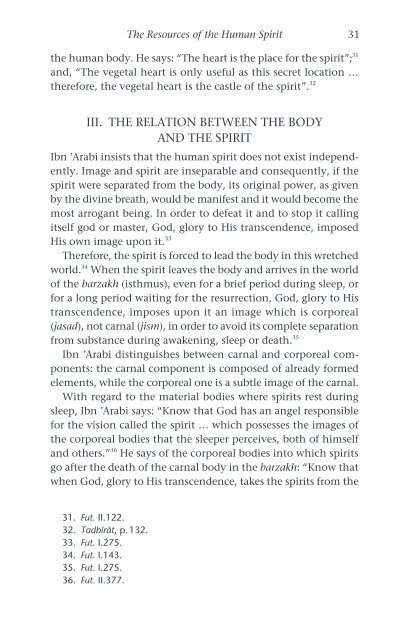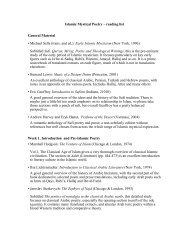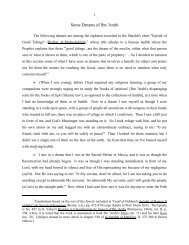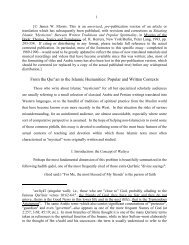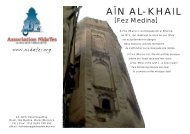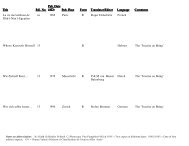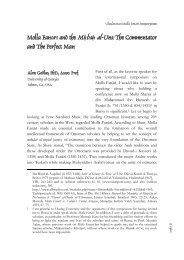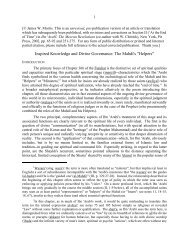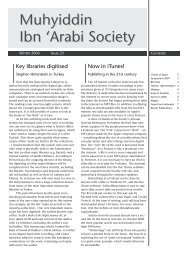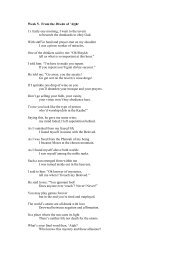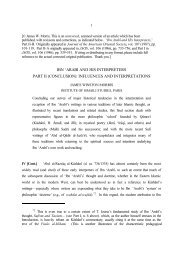The Resources of the Human Spirit - Muhyiddin Ibn Arabi Society
The Resources of the Human Spirit - Muhyiddin Ibn Arabi Society
The Resources of the Human Spirit - Muhyiddin Ibn Arabi Society
You also want an ePaper? Increase the reach of your titles
YUMPU automatically turns print PDFs into web optimized ePapers that Google loves.
<strong>The</strong> <strong>Resources</strong> <strong>of</strong> <strong>the</strong> <strong>Human</strong> <strong>Spirit</strong>31<strong>the</strong> human body. He says: “<strong>The</strong> heart is <strong>the</strong> place for <strong>the</strong> spirit”; 31and, “<strong>The</strong> vegetal heart is only useful as this secret location …<strong>the</strong>refore, <strong>the</strong> vegetal heart is <strong>the</strong> castle <strong>of</strong> <strong>the</strong> spirit”. 32III. <strong>The</strong> relation between <strong>the</strong> bodyand <strong>the</strong> spirit<strong>Ibn</strong> ¡<strong>Arabi</strong> insists that <strong>the</strong> human spirit does not exist independently.Image and spirit are inseparable and consequently, if <strong>the</strong>spirit were separated from <strong>the</strong> body, its original power, as givenby <strong>the</strong> divine breath, would be manifest and it would become <strong>the</strong>most arrogant being. In order to defeat it and to stop it callingitself god or master, God, glory to His transcendence, imposedHis own image upon it. 33<strong>The</strong>refore, <strong>the</strong> spirit is forced to lead <strong>the</strong> body in this wretchedworld. 34 When <strong>the</strong> spirit leaves <strong>the</strong> body and arrives in <strong>the</strong> world<strong>of</strong> <strong>the</strong> barzakh (isthmus), even for a brief period during sleep, orfor a long period waiting for <strong>the</strong> resurrection, God, glory to Histranscendence, imposes upon it an image which is corporeal(jasad), not carnal (jism), in order to avoid its complete separationfrom substance during awakening, sleep or death. 35<strong>Ibn</strong> ¡<strong>Arabi</strong> distinguishes between carnal and corporeal components:<strong>the</strong> carnal component is composed <strong>of</strong> already formedelements, while <strong>the</strong> corporeal one is a subtle image <strong>of</strong> <strong>the</strong> carnal.With regard to <strong>the</strong> material bodies where spirits rest duringsleep, <strong>Ibn</strong> ¡<strong>Arabi</strong> says: “Know that God has an angel responsiblefor <strong>the</strong> vision called <strong>the</strong> spirit … which possesses <strong>the</strong> images <strong>of</strong><strong>the</strong> corporeal bodies that <strong>the</strong> sleeper perceives, both <strong>of</strong> himselfand o<strong>the</strong>rs.” 36 He says <strong>of</strong> <strong>the</strong> corporeal bodies into which spiritsgo after <strong>the</strong> death <strong>of</strong> <strong>the</strong> carnal body in <strong>the</strong> barzakh: “Know thatwhen God, glory to His transcendence, takes <strong>the</strong> spirits from <strong>the</strong>31. Fut. II.122.32. Tadb¨råt, p. 132.33. Fut. I.275.34. Fut. I.143.35. Fut. I.275.36. Fut. II.377.


